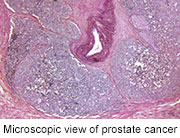Upgrading, up staging linked to age >60, PSA >5.0 ng/ml, and >25 percent positive cores
FRIDAY, July 17, 2015 (HealthDay News) — Many clinically low-risk prostate cancer patients are upgraded at prostatectomy, according to a study published in the August issue of The Journal of Urology.
Kathryn T. Dinh, from Harvard Medical School in Boston, and colleagues studied 10,273 patients from the Surveillance, Epidemiology, and End Results database diagnosed with clinically low-risk disease. The authors sought to examine the incidence of pathological upgrading and up staging. Participants who had cT1c/T2a, prostate-specific antigen <10 ng/ml, and Gleason 3+3=6 in 2010 to 2011 and treated with prostatectomy were identified and included in analyses.
The researchers found that 44 and 9.7 percent of cases were upgraded and up staged, respectively, at prostatectomy. Age, prostate-specific antigen, and percent positive cores, but not race, correlated with occult, advanced disease on multivariable analysis of 5,581 patients (all P < 0.001). With these variables dichotomized at the median, significant associations with upgrading were seen for age >60 years, prostate-specific antigen >5.0 ng/ml, and >25 percent positive cores (adjusted odds ratios [aORs], 1.39, 1.28, and 1.76; all P < 0.001). These variables were also associated with up staging (aORs, 1.42, 1.44, and 2.26; P < 0.001).
“Low-risk patients should be considered for further diagnostic imaging or guided biopsies based on prostate-specific antigen and percent positive cores before choosing active surveillance,” the authors write.
Two authors disclosed financial ties to the medical device and biopharmaceutical industries.
Copyright © 2015 HealthDay. All rights reserved.








